In this article we review the $2,100 USD Astell&Kern ACRO CA1000 amplifier.
The Astell&Kern ACRO CA1000 is a $2,1000 USD “Carriable Headphone Amp” that blurs the lines between the functionality and portability of a Digital Audio Player (DAP) and a traditional desktop headphone amplifier. We take this latest category-defying product from South Korea’s Astell&Kern through its paces in this review to see whether the ACRO CA1000 is either head-scratchingly niche, or one of the most innovative and versatile devices to hit the head-fi market in recent years.
Note: Astell&Kern kindly shared a review sample of the ACRO CA1000 with Headfonia for the purposes of this review. Astell&Kern is not associated with Headfonia in any way, and we thank them for the opportunity.
First, a personal note
Before I get into today’s review I want to let readers know that this article will be my last here at Headfonia – after three years and some 60+ articles, the time has come to sadly hang up my hat. I’d like to give a huge “thank you” to Lieven for taking me on as the newbie on the team back in 2019 – it’s been an amazing experience to work with such a great team and to have the chance to experience some terrific products along the way.
I’ve learned a ton since I came on board, and I’ve been able to find myself a gig in the audio industry as a result of what I’ve learned around here. All the best to all the Headfonia team, I look forward to seeing lots of great work in the future!
The world’s first “Carriable” headphone amp?
I need to get something off my chest right from the get-go – when I first saw Astell&Kern’s announcement for the new ACRO CA1000 I couldn’t quite work out what the hell it was meant to be. It looked for all the world like a DAP had been transplanted on top of some kind of art deco-looking silver block – you know that episode of The Simpsons where Homer designs a new kind of car? Yep, that’s where my mind first went. And, the ACRO CA1000 was being called a “Carriable Headphone Amp” – carriable? I mean sure, most headphone amplifiers are technically “carriable”, but just who is this new product aimed at? Astell&Kern isn’t afraid of pushing the boat out when it comes to unconventional design and creating products that no one has technically “asked for”, but the ACRO CA1000 sure was a surprise, to say the least.
So while this is my last review article for Headfonia, I may have ended up saving one of the most interesting ones until last. The ACRO CA1000 turned out to be one of the most versatile and useful personal audio products that I’ve come across during my time in the hobby – it sure gave me a pleasant surprise both in terms of its performance, and just how useful it can be in a number of different listening applications.
ACRO CA1000 – so what is it, exactly?
Astell&Kern, as I’m sure you’ll know if you’re a returning reader, is one of the world’s leading Digital Audio Player (a.k.a. “DAP”) makers – they certainly know a thing or two when it comes to making excellent portable digital source devices, and I’ve had the pleasure of tangoing with a few of them during my time here at Headfonia. DAPs are great as portable audio companions and are usually best suited to listening with IEMs due to their lower power output compared to desktop devices, although many newer DAPs have plenty of grunt for partnering with full-sized headphones. However, seeing how DAPs usually pack a decent audiophile-grade DAC chip on board and are able to play all kinds of high-res files – either via onboard stored files or streamed over wifi – they also make for great source devices upstream of other equipment. I often plug a DAP straight into my two-channel hifi system as a convenient way of piping hi-res music into my speaker system, but plonking a small portable player on top of your AV rack isn’t always the most ergonomic arrangement – plus, there’s your device’s battery life to consider as well.
Ok, so we know that DAPs make great IEM-powering devices, decent headphone amplifiers, and decent DACs/source devices when called upon. But, what would it look like if a DAP were given a “proton pill” and suddenly transformed into something ready of taking on all these jobs, and then some? Well, ladies and gentlemen, enter the ACRO CA1000.

I can understand why the team at Astell&Kern settled on the phrase “Carriable Headphone Amp” to stick on the box – there really isn’t anything else succinct enough to describe quite what the ACRO CA1000 is, or what it can do. But, it’s far more comprehensive than simply a headphone amp that you can pick up and move around with you. To describe it simply, Astell&Kern have taken the screen, functionality and digital smarts of one of their higher-end DAPs, and melded it with a desktop-ready discrete headphone amplifier with enough grunt and multiple outputs that make it ready for pairing with anything from IEMs, to hard-to-drive headphones. And with multiple digital inputs, Bluetooth and wifi capability, plus RCA analogue inputs and outputs, the ACRO CA1000 is also ready to function as an audiophile-grade DAC and preamplifier upstream of other audio equipment, such as power amplifiers or powered monitors.
And as for the “carriable” part? Well, the ACRO CA1000 features a non-inconsiderable 8,400mAh 3.8V Li-Polymer battery, making it very much a portable proposition that’s rated for up to 10.5 hours of playback.
There’s definitely quite a bit to unpack here in terms of what the ACRO CA1000 is, and also how it can be used. But, before we do we’d better dive in and take a closer look at what’s under the hood and how the ACRO CA1000 works.
ACRO CA1000 technical specifications:
- Display: 4.1 inch 720 x 1280 touch screen
- Supported Audio Formats: WAV, FLAC, WMA, MP3, OGG, APE, AAC, ALAC, AIFF, DFF, DSF, MQA
- Sample Rate PCM : 8kHz ~ 384kHz (8/16/24/32bits per Sample) / DSD Native: DSD64(1bit 2.8MHz), Stereo /
DSD128(1bit 5.6MHz), Stereo / DSD256(1bit 11.2MHz), DSD512(1bit, 22.4MHz) Stereo - Output Level (Headphone Out) [Low] Unbalanced 2Vrms / Balanced 4Vrms (Condition No Load),
[Mid] Unbalanced 4Vrms / Balanced 8Vrms (Condition No Load),
[High] Unbalanced 6Vrms / Balanced 12Vrms (Condition No Load),
[Super] Unbalanced 8Vrms / Balanced 15Vrms (Condition No Load) - Output Level (RCA Out) 2Vrms (Condition No Load)
- CPU: Quad-core
- DAC ESS ES9068AS x4 (Quad-DAC)
- Decoding Support up to 32bit / 384kHz Bit-to-Bit playback
- Headphone Outputs: Unbalanced (3.5mm, 6.35mm) / Balanced (2.5mm, 4.4mm)
- Analog Inputs Outputs: RCA (Stereo pair) x1
RCA (Stereo pair) x1 - Digital Inputs/Outputs: Coaxial x1, Optical x1, USB(Type-C) x1
Optical(3.5mm) x1, USB(Type-C) x1 - Wi-Fi 802.11 a/b/g/n/ac (2.4/5GHz)
- Bluetooth V5.0 (A2DP, AVRCP, Qualcomm® aptX™ HD, LDAC)
- Dimensions 4.12″(104.9mm)[W] x 1.77″(45mm)[H] x 5.85″(148.8mm)[D]
- Weight: about 32.41oz (919g)
- Built-in Memory 256GB [NAND]
- External Memory microSD x1 (Max. 1TB)
- Battery
- Capacity 8,400mAh 3.8V Li-Polymer
- Charge Time about 2.5 hours (9V / 3A PD2.0 Fast Charging) | 7 hours (5V 2A General Charging)
- Playback Time about 10.5 hours (Standard : FLAC, 16bit, 44.1kHz, Unbalanced, Vol.40, LCD Off, Low Gain)
Audio Specifications
- Frequency Response ±0.024dB (Condition : 20Hz~20kHz) Unbalanced / ±0.018dB (Condition : 20Hz~20kHz) Balanced /
±0.048dB (Condition : 20Hz~20kHz) RCA
±0.059dB (Condition : 20Hz~70kHz) Unbalanced / ±0.056dB (Condition : 20Hz~70kHz) Balanced /
±0.048dB (Condition : 20Hz~70kHz) RCA - S/N 107dB @ 1kHz, Unbalanced / 115dB @ 1kHz, Balanced / 119dB @ 1kHz, RCA
- Crosstalk -105dB @ 1kHz, Unbalanced / -124dB @ 1kHz, Balanced / -121dB @ 1kHz, RCA
- THD+N 0.005% @ 1kHz, Unbalanced / 0.002% @ 1kHz, Balanced / 0.0004% @ 1kHz, RCA
- IMD SMPTE 0.0008% 800Hz 10kHz (4:1) Unbalanced / 0.0004% 800Hz 10kHz (4:1) Balanced /
0.0003% 800Hz 10kHz (4:1) RCA - Output Impedance 3.5mm, 6.35mm (1ohm), 2.5mm, 4.4mm (2ohm), RCA (2ohm)
- Clock Jitter 25ps (Typ)
- Reference Clock Jitter 70ps
- Memory
Unboxing and accessories
The retail packaging for the ACRO CA1000 is typically premium as I’ve come to expect from Astell&Kern. While it arrives inside a nice lift-off-top solid black cardboard case with a snug foam surrounding, the biggest thing I think it’s missing – particularly for the price – is a decent portable protection solution. Given it has the word “Carriable” on the box and “transportability” is one of the key features of the ACRO CA1000, it’d be nice to be able to put it safely into your luggage or backpack for taking on the road with you, but owners who do so will need to look into after-market solutions. And being such a chunky device with hard, sharp corners, it’s going to need to be a pretty solid case to avoid damage to other items!
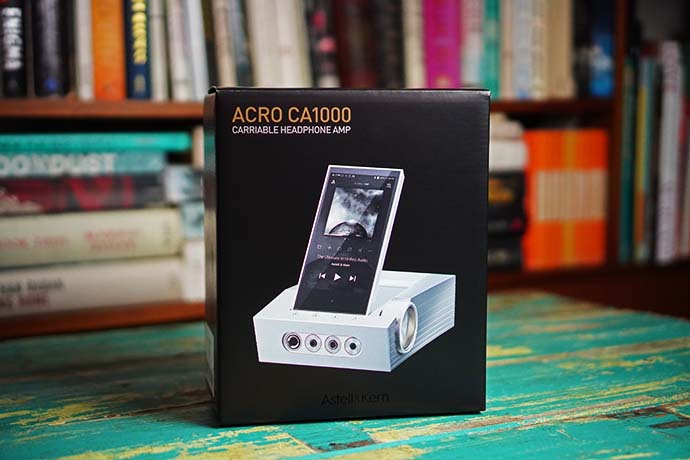
In terms of accessories, the ACRO CA1000 has been treated the same as the remainder of the DAPs in the Astell&Kern line-up: you get yourself a USB-C cable for charging and data, warranty and quick-start literature plus a few screen protector clear plastics films for popping on top of the touchscreen.
ACRO CA1000 design and features
When delving into this interesting little machine, it’s probably easiest to separate it into two parts: the “DAP” part, and the “amp” part – that is, the folding screen section on the top of ACRO CA1000, and the main aluminium body downstairs, respectively.
The main screen interface, or the “DAP” part of the ACRO CA1000, is classic Astell&Kern in terms of its user interface and functionality. The 720 x 1080 touch screen gives you access to Astell&Kern’s reskinned take on a basic Android operating system, which is powered by a Quad-Core CPU. Astell&Kern didn’t skimp when it came to divvying out DAC chips with the ACRO CA1000 – it gets no fewer than four ESS ES9068AS chips which allows it to process 32-bit/384kHz PCM, DSD 512 and MQA 8x. The screen itself folds in a 60-degree arc so that it can lie down flush with the body of the amp, or folded upwards which is great if you have it sitting just below eye level on your desktop – it makes looking at and interacting with the touch screen a breeze.

In terms of wireless capabilities, the ACRO CA1000 uses the latest Bluetooth 5.0 and is compatible with the higher-res aptX HD and LDAC codecs – both as a Bluetooth receiver (using another device like your smartphone as a source), and a Bluetooth source (using the ACRO 1000 to send a signal to headphone, external speakers etc). The ACRO CA1000 also features dual-band 2.4/5GHz wifi capability, with access to the usual range of music streaming apps that can either be downloaded via the “Services” tab on the device or “sideloading” the requisite APK file via your Mac/PC. Wifi also allows the ACRO CA1000 to receive over-the-air firmware updates – I was prompted to install one shortly after this review unit arrived, and among other things it meant that the ACRO CA1000 became a “Roon Ready” device – as a daily Roon user, this made me very happy indeed.
Moving down from the “DAP” part, we have one very solid, single piece of milled aluminium making up the main body of the ACRO CA1000, which makes the total device weigh in at just under one kilogram. Astell&Kern claim that the design of the unit was inspired by a “Mars Rover” – if you squint your eyes enough I guess it does? Mars Rovers aside, it’s a pretty sweet-looking little chunk of metal and it is one solidly-built device – I’d happily have one parked on my desktop. It gets my tick of approval for one simple reason – it’s heavy enough that I can plug/unplug my headphones without it sliding around on the glass top of my desk!
It wouldn’t be an Astell&Kern device without excellent, tactile physical controls and that’s certainly the case here. The ACRO CA1000 boasts a large volume “wheel” that precisely changes levels digitally, and four small buttons each manage power on/off, track rewind, play/pause, and track forward.
Despite being a relatively compact device, the ACRO CA1000 proudly marks itself as ready to be a “proper” desktop headphone amplifier by virtue of its 4 x different headphone connections: 6.4mm and 3.5mm single-ended, and 4.4mm and 2.5mm balanced. To help make the ACRO CA1000 as suitable as possible with all sorts of headphones, from the most sensitive IEMs all the way up to beefy planars, it’s been equipped with four different gain settings to help provide the right drive and volume control depending on what you’re using with it. Astell&Kern rate the ACRO CA1000 as capable of pushing out a healthy 15Vrms from the balanced outputs in “Super” mode. It’s a little more common to rate desktop headphone amplifiers in terms of Watts per channel yet this hasn’t been provided by the manufacturer, however, another publication has calculated that the +12dB of gain from the “Super” setting is good for 2.1 Watts into 32 ohms, and 126mW into 600 ohms – not bad at all!
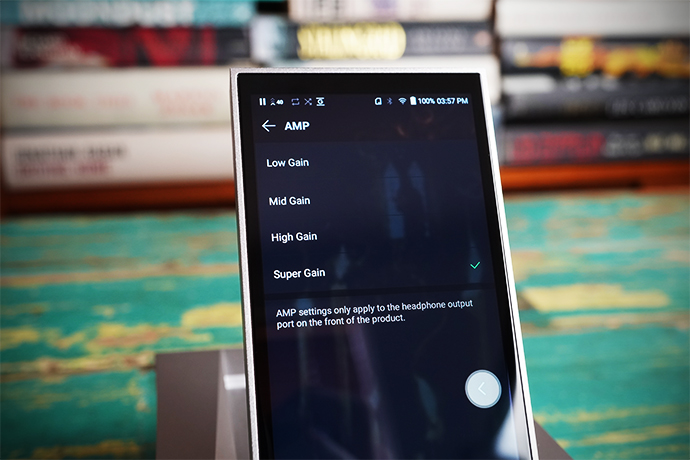
Spinning it around to the rear of the device, the ACRO CA1000 offers a pair of RCA analogue inputs, plus a pair of RCA outputs – like a standard headphone amplifier, so that ACRO CA1000 can amplify an external digital or analogue line-level source, and can also work as a pre-amplifier for powered monitors of power amplifiers via the RCA output. Just note that any incoming RCA signal will go through a 24-bit/48 kHz analogue-to-digital conversion process, but I don’t exactly see this mode being the primary use-case for most ACRO CA1000 owners anyhow. Still, it’s nice that you can hook up a turntable to it when you get the urge to!
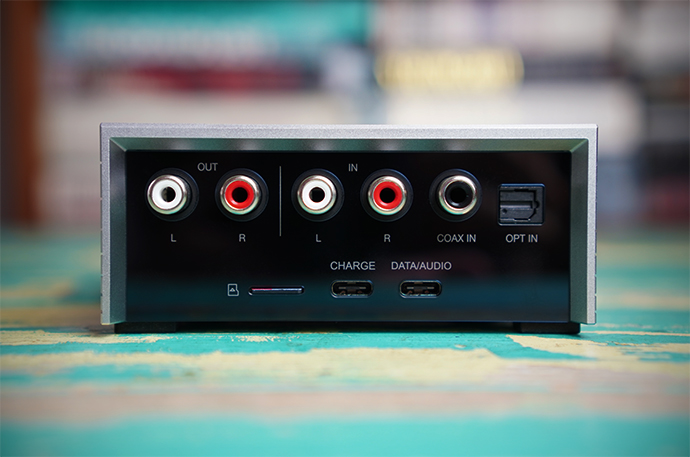
The ACRO CA1000’s 4 x ES9068AS DACs can be hooked-up with external digital sources such as CD players, TVs and so forth via the optical and coaxial inputs, and a pair of USB-c female connections serve as the data/audio and charging ports respectively. Lastly, a MicroSD card slot allows you to add up to 1 TB of external storage to supplement the 256 GB of storage onboard the ACRO CA1000.
Click over to page 2 to continue the review.







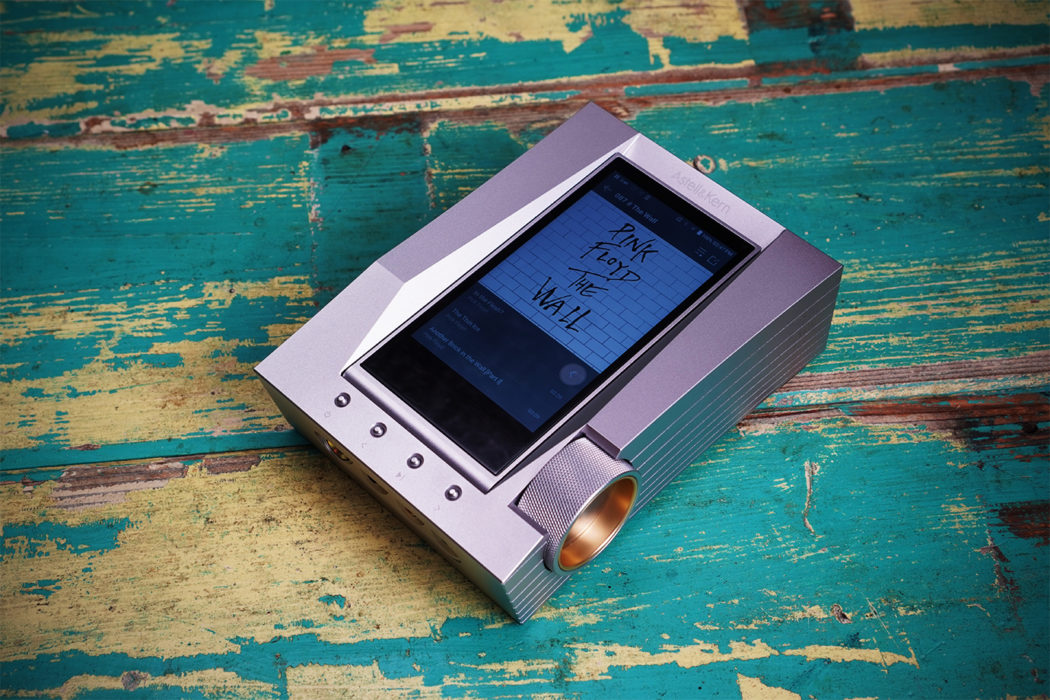
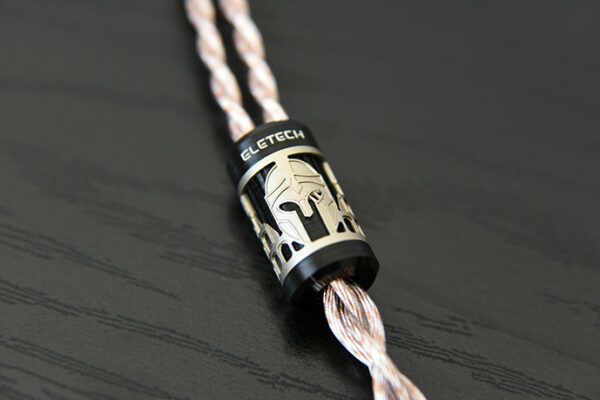
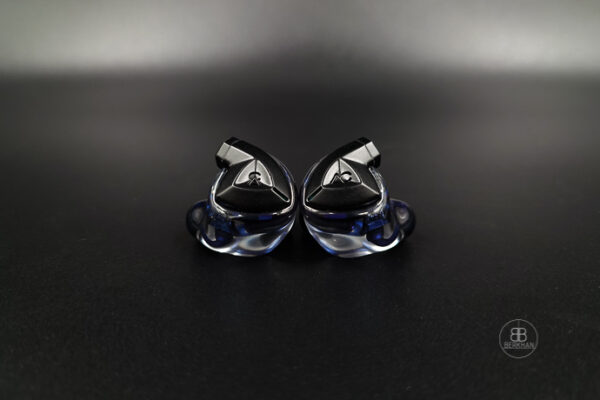
Booker
It feels like just last year you started at Headfonia! I guess the pandemic has completely warped my sense of time though… All the best for your next endeavours, you’ll be missed 🙂
Also, I actually really like the idea behind this. Recently I’ve been browsing over streaming servers, NAS drives and all the associated interconnects and cables that would be required, and an all-in-one player and storage system just seems so much more appealing due to its simplicity. But likewise, I don’t think I’d be transporting this anywhere, so something like the Naim Atom headphone edition would be an interesting competitor, or the similar oversized-DAP looking iBasso Max editions as an alternative.
Matty Graham
Thanks for the kind words mate, much appreciated!
Yep, the CA1000 is pretty compelling as a neat desktop source – I can see many people choosing one for its storage and seamless user experience alone!
Anders B
So how does the sound compare with Mojo2.. I’m looking for the next step up and don’t really need more than DAC functionality..
Philippe Sandmeier
Hi Matty, interesting review of a fairly unique product. Any comments on how it compares to Shanling’s EM5?
Good luck with your new ventures.
Matty Graham
Hi Philippe, thank you! The EM5 looks fairly similar in terms of adding a source/streaming component to a DAC/amp, but lacks the portability and battery of the CA1000. If you’re only looking for a desktop solution the Shanling may be a more affordable option, but I can’t comment on how it sounds as I’ve never heard it.
Vincent
Hey Matty, thank you for the good work on this underreviewed product! Any chance you could give me a hint about the way it compares to the SE180 (any SEM)? Thanks!
Pat
Hi! I just read a review of The ACRO CA1000T. The tester says that it can tame the trebles of the He1000V2. I have the SE and I also have sometimes the treble issue. According to your exprience, what DAP should be warm enough to calm them down?? Thanks.